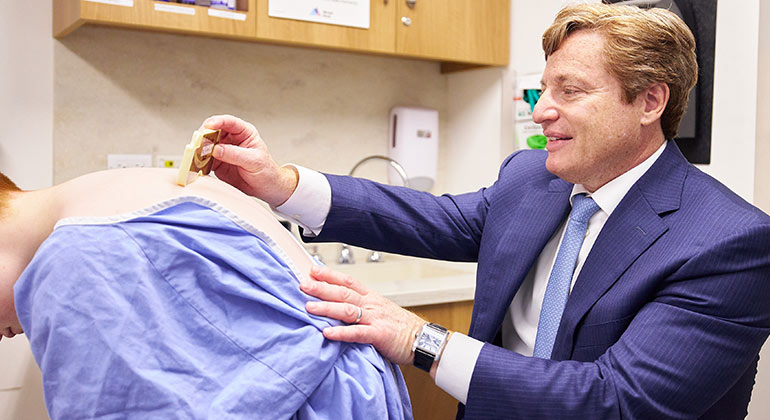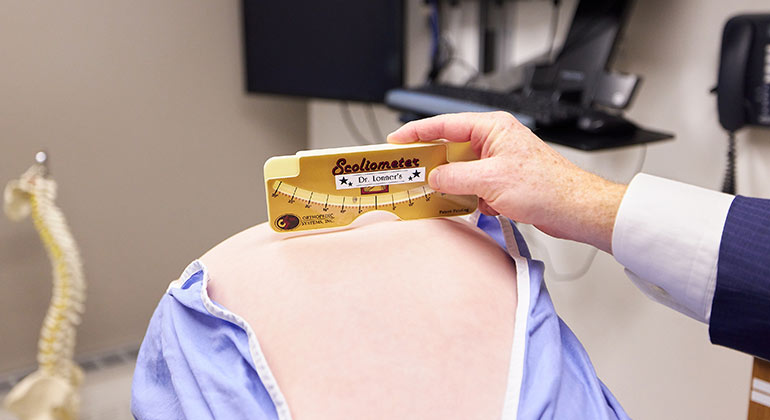Children’s Scoliosis


Scoliosis changes the normal shape of the spine. The good news is that children with scoliosis rarely feel pain from the condition. In fact, we often find out there’s a problem when you—or your pediatrician—sees that your child’s back doesn’t look quite right. You might notice that when your child bends over:
- One shoulder or hip looks like it is higher than the other
- One shoulder blade appears higher and sticks farther out than the other one
- One arm hangs longer than the other because the upper body is tilted
- A rib hump, a hump on the back that sticks up when the spine bends forward
As the condition progresses, your child may experience back pain. The curvature of the spine may put pressure on certain nerves and possibly on the spinal cord. This can lead to weakness, numbness, and pain in the legs. In rare and severe cases, scoliosis can cause the chest to become deformed, which can affect the lungs and heart. This can lead to breathing problems, fatigue, and even heart failure. At Mount Sinai, we try to address scoliosis long before that happens.
Diagnosing Scoliosis
If you look at a healthy spine from the side, its natural curves form an S shape. The neck (called the cervical spine) curves slightly forward; the middle back (thoracic spine) curves backward; and the lower back (lumbar spine) curves forward. You can only see the curves from the side, though. If you look at the spine from the back or front, the spine typically looks straight. When your child’s spine twists and develops side-to-side curves, we call it scoliosis. Scoliosis can occur in either the thoracic or lumbar spine, or both. Orthopedists measure the severity of scoliosis in degrees of curvature, ranging from as little as ten degrees to extreme cases of more than 100 degrees.
To diagnose scoliosis, we start with a physical exam and a family and medical history. We may ask when the symptoms began; whether your child has had back surgery; and if there is any pain or bowel or bladder pain or difficulty moving (motor dysfunction). We may also need to use imaging tests to gather more information. These tests might include:
- X-rays to measure the degree of curvature
- Magnetic resonance imaging (MRI) to look at the nerves and spinal cord
- Computerized tomography (CT) scan to get a better picture of the vertebral bones
We might also order special nerve tests to see if the scoliosis has irritated or pinched any nerves.
Types of Scoliosis
Doctors divide scoliosis into categories based on the child’s age when diagnosed:
- Infantile scoliosis is diagnosed before age 3
- Juvenile scoliosis is diagnosed from age 3 to 10
- Adolescent scoliosis is diagnosed between ages 10 and 15
Infantile Scoliosis: When we see scoliosis in infants, we usually just observe the child because most cases are relatively minor and almost 90 percent of them resolve themselves without any treatment. However, it is still important for your baby’s pediatrician to monitor the curve because if it progresses, surgery may be necessary. If a child is born with this condition, we call it congenital scoliosis.
Juvenile and Adolescent Scoliosis: We usually discover scoliosis in childhood or adolescence, when rapid growth tends to accelerate the progression of spinal curves. If your child is otherwise healthy and we can find no specific cause, we call the condition juvenile idiopathic scoliosis. Idiopathic scoliosis represents 80 to 85 percent of all forms of scoliosis. Idiopathic scoliosis affects about three percent of the general population. If the child develops the condition before age nine, we call it early-onset scoliosis.
Scoliosis Treatment
Our expert physicians will develop a treatment plan based on the child’s age when scoliosis began, the degree of curvature, and any other symptoms. For curves of less than 40 degrees, conservative treatment is often enough to stop the condition from progressing. Conservative treatments may include medication, bracing, physical therapy, and exercise.
Curves greater than 40 degrees, however, are a different story. If a child has a medium or large curve, it can continue to get worse into adulthood and can lead to secondary symptoms. These symptoms can include severe pain, difficulty breathing, or increasing deformity. For these reasons, your child might benefit from surgery. Surgery for scoliosis is never an emergency and there’s always plenty of time to make everyone comfortable with the decision. We work with you and your family to decide whether your child should have surgery.
Traditionally, doctors have used spinal fusion, using rods to help straighten the spine. There are three ways to perform spinal fusion:
- A posterior approach, which involves entering the spine through the back
- An anterior approach, which is performed from the front or side
- A combined approach, which uses elements of both posterior and anterior approaches
A newer technique is called vertebral body tethering surgery. This minimally invasive procedure uses anchors and a flexible cord to guide the spine as it grows. It is also called non-fusion scoliosis surgery or minimally invasive scoliosis surgery.